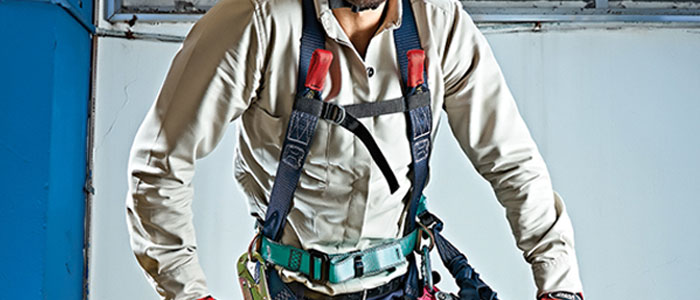Work at Height is performed at least 2 meters above the base where the worker is located, or when there is a potential risk of injury below this height. This type of activity requires special care with the Personal Protection Equipment that will be used, because accidents can cause permanent damages, force a worker to retire or even be fatal. This post will explain one of the main PPE for Work at Height: the Safety Harness.
The use of the Safety Harness complies with the requirements established by NR 35, which deals specifically with Working at Height, and also NR 6, which makes the use of PPE mandatory for activities that represent risk to the worker’s physical integrity.
The Safety Harness is used to keep the worker safe and secure whenever he performs any activity at height, being fixed to a point that will offer the necessary support for the execution of the work. The weight will be distributed among the connection points along the worker’s body and will serve to prevent him from falling. There is a Safety Harness model for each activity performed.
Main Safety Harnesses for Work at Height
Harness with 1 connection point: recommended for use with Twin Leg Lanyard, Rope Harness or Retractable Harness.
Confined Space Harness with shoulder straps: recommended for use with the trapeze for access to the confined space.
Harness with lateral connection point: for use with the Work Positioning Lanyard, which will keep the worker positioned and with hands free to perform any activities.
Harness for rope access, rescue and industrial mountaineering: recommended for tasks where the access is made by ropes that will support the worker.
Harness for hot work: recommended for activities with the use of welding or with high temperature (heat and fire).
Safety Harness and Connection Points
The safety harness presents different options of connection points to guarantee more safety, comfort, and mobility to the worker. These varieties are important to allow the professional to use the connection points that best meet the needs of his task.
The main connection points are
Dorsal attachment D-ring (fall arrest).
Frontal attachment D-ring, which can be a ring or a strap (fall arrest).
Shoulder straps (confined space access).
Two positioning rings on the waist.
Ventral D-Ring (support).
The Safety Harnesses for Work at Height are manufactured in synthetic material, polyester. With type of manufacturing the material is more comfortable, malleable, resistant and sturdy, whcih makes it easier to use.
Working at Height requires special care
Working at Height requires a lot of attention on the part of each worker in order to preserve their physical integrity. It is the employer’s responsibility to provide the necessary PPE for the execution of the tasks, among them the Safety Harness. And it is up to the professional to use each of his Safety Equipment correctly.
Did you like this Post? Do you have any different information about Safety Harnesses? Leave your comment below and let’s continue the conversation!
And whenever you need reliable information about Safety Belts, come visit us, because this is the Work at Height Experts Blog.
